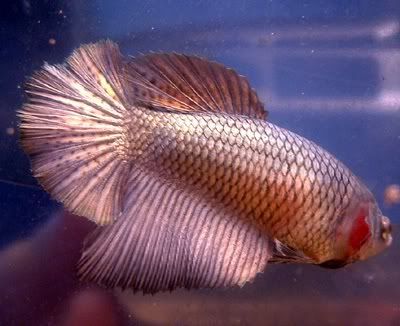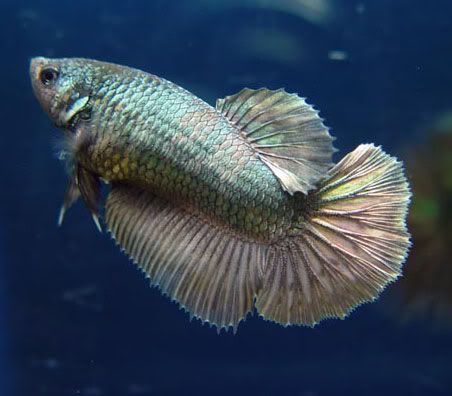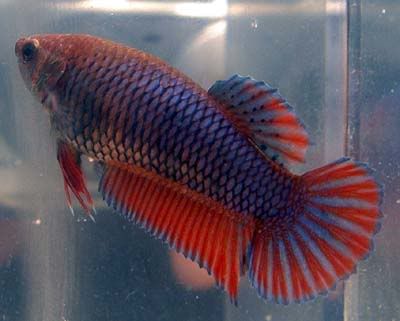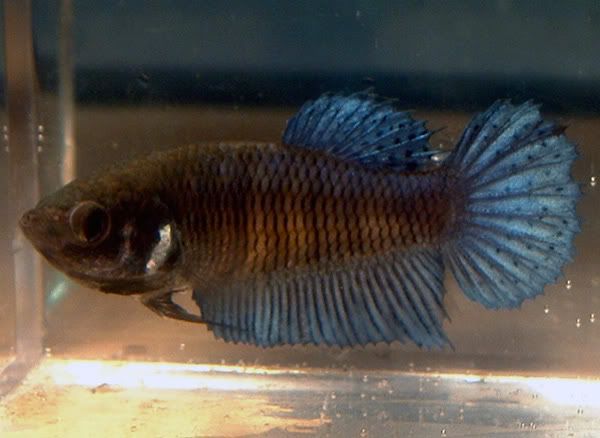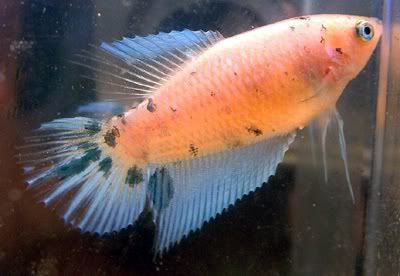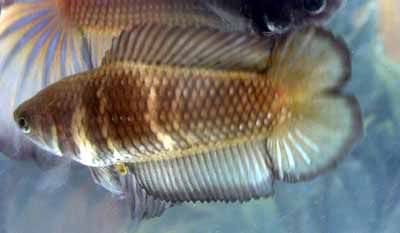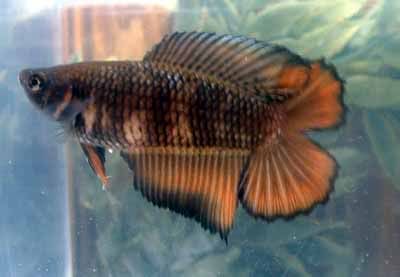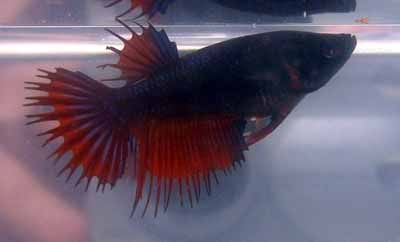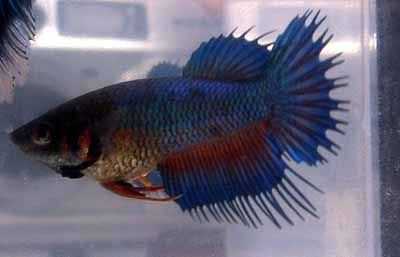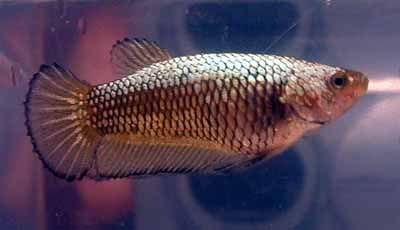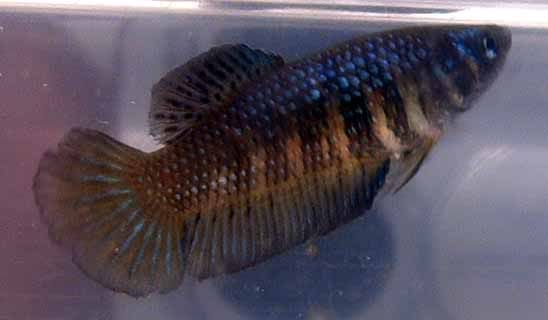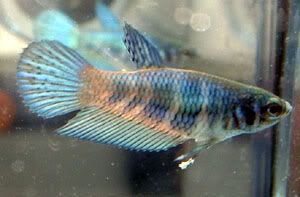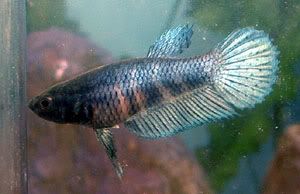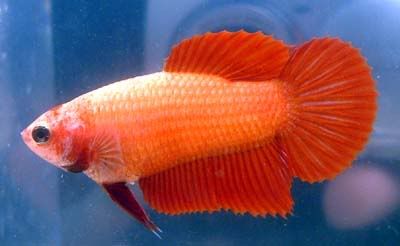Health information provided as a source of education and entertainment only. Please consult your veterinarian immediately if your pet is ill or needs preventive care.
COMMON DISEASES IN FRESH WATER FISH
BLACK SPOT DISEASE:
SCIENTIFIC NAME: Posthodiplostomum sp.
COMMON NAME(S): Black spot disease
SYMPTOMS: Small black spots present on body.
ORGANISM: Digenetic fluke
RECOMMENDED TREATMENT: Will usually go away on its own, as the complex life cycle of the fluke can not be completed in an aquarium. Otherwise, a five minute freshwater bath followed by formalin @ 75 ppm for one hour. Formalin is dangerous to use, so treat ONLY is a hospital tank, and wear gloves and goggles when handling.
CHILODONELLA:
SCIENTIFIC NAME: Chilodonella sp.
COMMON NAME(S): none
SYMPTOMS: Fish has a grey-white film of excess mucus covering its body. Gills may be swollen.
ORGANISM: Ciliated protozoan
RECOMMENDED TREATMENT: Treat with .15 ppm malachite green and .50 ppm formalin. Dosage is given three times, two days apart. 2 ppm methylene blue should be added to the treatment if respiratory distress is evident. THIS IS A VERY CONTAGIOUS DISEASE, SO BE CAREFUL NOT TO SPREAD IT BY USING CONTAMINATED NETS AND HANDS IN OTHER AQUARIA.
Keep temp. at 75 dF.
DROPSY:
SCIENTIFIC NAME: varies with organism
COMMON NAME(S): Dropsy
SYMPTOMS: Swollen belly, usually with scales protruding at a 90 degree angle. Redding of vent area, and long, pale feces.
ORGANISM: Bacterial, viral infections or nutritional disorder.
RECOMMENDED TREATMENT: No effective treatment. Remove affected fish to quarantine tank and give the best possible food and water quality. If fish does not improve, euthanasia may be in order.
SCIENTIFIC NAME: varies with organism
COMMON NAME(S): Dropsy
SYMPTOMS: Swollen belly, usually with scales protruding at a 90 degree angle. Redding of vent area, and long, pale feces.
ORGANISM: Bacterial, viral infections or nutritional disorder.
RECOMMENDED TREATMENT: No effective treatment. Remove affected fish to quarantine tank and give the best possible food and water quality. If fish does not improve, euthanasia may be in order.
EYE FUNGUS:
SCIENTIFIC NAME: varies according to fungal species
COMMON NAME(S): eye fungus
SYMPTOMS: Eyes may appear to have a white coating.
ORGANISM: saprophitic fungi
RECOMMENDED TREATMENT: A mixture of Potassium dichromate and Silver Nitrate works the best. This is available through Aquatronics as Eye-Fungex. First, one is painted on the infected area, then the other. Follow directions on package.
FISH LOUSE:
SCIENTIFIC NAME: Argulus sp.
COMMON NAME(S): Fish louse
SYMPTOMS: The flat, somewhat rounded parasites can be seen crawling over the skin of the infected fish.
ORGANISM: Parasitic crustacea
RECOMMENDED TREATMENT: Dylox at a dose of .75 ppm. This dose is repeated three times, three days apart.
OTHER TREATMENT ALTERNATIVE: copper sulphate @ .20 ppm until parasites have gone.
ON USING COPPER: For several diseases listed , copper is mentioned as the treatment of choice (TOC) or as an alternate treatment. When speaking of copper, I am referring to citrated copper (ex: Sea Cure). At NO time should you be using heavily bonded or chelated coppers, as they are NOT as effective against the disease, and you can not measure the amount of copper in your system. Heavily bonded coppers are also much more difficult to remove from your system once the treatment is finished. In order for copper to be effective against a given disease, it must be in the ionic form, and heavily bonded coppers do not meet this parameter. The use of copper also suppresses the immune system for a time, so be aware of any bacterial infections that may set in. Feeding Tetra medicated food for bacterial problems is a good idea during copper treatment. Be careful when dosing copper in freshwater aquaria as the low pH levels usually found in freshwater aquaria make the copper extreamly toxic. Once treatment is finished, remove the copper from th!
e system by doing water changes and adding PolyFilters to the filter system. If you are treating in a hospital tank, allow the fish to recouperate from the treatment for two days before adding it to your display tank. Also remember to remove any chemical filtrants before using ANY medication. All treatments herein assume that the fishes will be treated in a hospital tank. Certain medications (antibiotics, methylene blue) will disrupt biological filtration. If you must treat in your display tank, keep a close watch out for a rise in ammonia.
ON METHYLENE BLUE: Some of the treatments require the addition of 2 ppm methylene blue. This is done in cases where gill damage may be present, as methylene blue acts as an oxygen carrier, easing the stress on the fish.
SCIENTIFIC NAME: Argulus sp.
COMMON NAME(S): Fish louse
SYMPTOMS: The flat, somewhat rounded parasites can be seen crawling over the skin of the infected fish.
ORGANISM: Parasitic crustacea
RECOMMENDED TREATMENT: Dylox at a dose of .75 ppm. This dose is repeated three times, three days apart.
OTHER TREATMENT ALTERNATIVE: copper sulphate @ .20 ppm until parasites have gone.
ON USING COPPER: For several diseases listed , copper is mentioned as the treatment of choice (TOC) or as an alternate treatment. When speaking of copper, I am referring to citrated copper (ex: Sea Cure). At NO time should you be using heavily bonded or chelated coppers, as they are NOT as effective against the disease, and you can not measure the amount of copper in your system. Heavily bonded coppers are also much more difficult to remove from your system once the treatment is finished. In order for copper to be effective against a given disease, it must be in the ionic form, and heavily bonded coppers do not meet this parameter. The use of copper also suppresses the immune system for a time, so be aware of any bacterial infections that may set in. Feeding Tetra medicated food for bacterial problems is a good idea during copper treatment. Be careful when dosing copper in freshwater aquaria as the low pH levels usually found in freshwater aquaria make the copper extreamly toxic. Once treatment is finished, remove the copper from th!
e system by doing water changes and adding PolyFilters to the filter system. If you are treating in a hospital tank, allow the fish to recouperate from the treatment for two days before adding it to your display tank. Also remember to remove any chemical filtrants before using ANY medication. All treatments herein assume that the fishes will be treated in a hospital tank. Certain medications (antibiotics, methylene blue) will disrupt biological filtration. If you must treat in your display tank, keep a close watch out for a rise in ammonia.
ON METHYLENE BLUE: Some of the treatments require the addition of 2 ppm methylene blue. This is done in cases where gill damage may be present, as methylene blue acts as an oxygen carrier, easing the stress on the fish.
FLEXIBACTER:
SCIENTIFIC NAME: Flexibacter spp.
COMMON NAME(S): mouth "fungus"
SYMPTOMS: Off-white marks around the mouth. As the infection spreads, white cottony tufts may appear in the mouth region, along with red ulcers on the body and frayed fins. Fish may "shimmy" and go off feed.
ORGANISM: bacterial infection, poor water quality
RECOMMENDED TREATMENT: Neomycin sulphate @ 250 mg/gallon. This antibiotic is affective against a wide range of gram+ and gram - bacteria. Improve water quality.
SCIENTIFIC NAME: Flexibacter spp.
COMMON NAME(S): mouth "fungus"
SYMPTOMS: Off-white marks around the mouth. As the infection spreads, white cottony tufts may appear in the mouth region, along with red ulcers on the body and frayed fins. Fish may "shimmy" and go off feed.
ORGANISM: bacterial infection, poor water quality
RECOMMENDED TREATMENT: Neomycin sulphate @ 250 mg/gallon. This antibiotic is affective against a wide range of gram+ and gram - bacteria. Improve water quality.
ICK:
SCIENTIFIC NAME: Ichthyophthirius multifiliis
COMMON NAME(S): ick, white spot disease
SYMPTOMS: Large white spots on the fins and body of the infected fish.
ORGANISM: Ciliated protozoan
RECOMMENDED TREATMENT: .15 ppm malachite green. 3 treatments, two days apart.
SCIENTIFIC NAME: Ichthyophthirius multifiliis
COMMON NAME(S): ick, white spot disease
SYMPTOMS: Large white spots on the fins and body of the infected fish.
ORGANISM: Ciliated protozoan
RECOMMENDED TREATMENT: .15 ppm malachite green. 3 treatments, two days apart.
LERNIA:
SCIENTIFIC NAME: Lernia sp.
COMMON NAME(S): Anchor Worm
SYMPTOMS: "Worm" is seen on the body of the fish. Usually it is a female that is seen, with her two egg sacs on the rear of the parasite.
ORGANISM: Parasitic crustacean
RECOMMENDED TREATMENT: Remove parasite with tweezers, and paint the wound with tincture of iodine. In ponds, DYLOX, at a dose of .75ppm repeated every two days for three treatments, is advised.
SCIENTIFIC NAME: Lernia sp.
COMMON NAME(S): Anchor Worm
SYMPTOMS: "Worm" is seen on the body of the fish. Usually it is a female that is seen, with her two egg sacs on the rear of the parasite.
ORGANISM: Parasitic crustacean
RECOMMENDED TREATMENT: Remove parasite with tweezers, and paint the wound with tincture of iodine. In ponds, DYLOX, at a dose of .75ppm repeated every two days for three treatments, is advised.
POP EYE:
SCIENTIFIC NAME: varies with organism
COMMON NAME(S): pop-eye
SYMPTOMS: One or both eyes may protrude from their sockets.
ORGANISM: bacterial/parasitic infection, poor water quality, gas supersaturation.
RECOMMENDED TREATMENT: Neomycin sulphate @ 250 mg/gallon. This antibiotic is affective against a wide range of gram+ and gram - bacteria. Improve water quality, and make sure pumps are not sucking in air on the suction side.
SCIENTIFIC NAME: varies with organism
COMMON NAME(S): pop-eye
SYMPTOMS: One or both eyes may protrude from their sockets.
ORGANISM: bacterial/parasitic infection, poor water quality, gas supersaturation.
RECOMMENDED TREATMENT: Neomycin sulphate @ 250 mg/gallon. This antibiotic is affective against a wide range of gram+ and gram - bacteria. Improve water quality, and make sure pumps are not sucking in air on the suction side.
SKIN FUNGUS:
SCIENTIFIC NAME: varies according to fungal species
COMMON NAME(S): skin fungus, body fungus
SYMPTOMS: Cottony tufts present on fins or body,
usually around open wounds.
ORGANISM: saprophitic fungi
RECOMMENDED TREATMENT: A mixture of Potassium dichromate and Silver Nitrate works the best. This is available through Aquatronics as Eye-Fungex. First, one is painted on the infected area, then the other. Follow directions on package.
SCIENTIFIC NAME: varies according to fungal species
COMMON NAME(S): skin fungus, body fungus
SYMPTOMS: Cottony tufts present on fins or body,
usually around open wounds.
ORGANISM: saprophitic fungi
RECOMMENDED TREATMENT: A mixture of Potassium dichromate and Silver Nitrate works the best. This is available through Aquatronics as Eye-Fungex. First, one is painted on the infected area, then the other. Follow directions on package.
OTHER TREATMENT ALTERNATIVE: SEE OUR MONTHLY SPECIALS….
CERTAIN MEDICATIONS (ANTIBIOTICS, METHYLENE BLUE) WILL DISRUPT BIOLOGICAL FILTRATION ETC.
CERTAIN MEDICATIONS (ANTIBIOTICS, METHYLENE BLUE) WILL DISRUPT BIOLOGICAL FILTRATION ETC.
Symptoms: Very small white speckles on fish. Resembles a fine powder.
Treatment: There are many commercially available products to cure Velvet. Among them are Maracide by Mardel Laboratories and Super Velvet by Aquatronics.
Information: Velvet, or Oodinium, is a very common disease which resembles Ich. The white pustules are much finer and are located mainly on the body. It is a little easier to cure than Ich, since the life cycle is not so rapid. It commonly follows chilling or stress caused by transportation or poor water quality.
Treatment: There are many commercially available products to cure Velvet. Among them are Maracide by Mardel Laboratories and Super Velvet by Aquatronics.
Information: Velvet, or Oodinium, is a very common disease which resembles Ich. The white pustules are much finer and are located mainly on the body. It is a little easier to cure than Ich, since the life cycle is not so rapid. It commonly follows chilling or stress caused by transportation or poor water quality.
INDIAN ALMOND LEAF - AN ASIAN SECRET - IT WORKS LIKE MAGIC !
The Sea Almond tree produces a substance in its leaves and sap to defend against insect parasites. The dried leaves are ideal for reducing losses due to bacterial disease, and keeping sensitive species.
Add one leaf per 10-15 gallons of water for all sensitive fishes such as baby discus, dwarf cichlids, rare bettas and all black water tetras, rasboras and catfishes.
You will be amazed at the results and improved vitality and breeding frequency in your fish. The leaves have been a long kept secret in Asia where they are used by many breeders and wholesalers.
Traditional medicinal uses:
Leaves, bark and fruits: dysentery (Southeast Asia); dressing of rheumatic joints (Indonesia, India).
Fruits and bark: coughs (Samoa), asthma (Mexico).
Fruits: leprosy, headaches (India),
Ripe fruits: travel nausea (Mexico)
Leaves: get rid of intestinal parasites (Philippines); treat eye problems, rheumatism, wounds (Samoa); stop bleeding during teeth extraction (Mexico), fallen leaves used to treat liver diseases (Taiwan), young leaves for colic (South America).
Juice of leaves: scabies, skin diseases, leprosy (India, Pakistan)
Bark: throat and mouth problems, stomach upsets and diarrhoea (Samoa); fever, dysentery (Brazil).
Modern research has identified some properties which could be used to treat high blood pressure.
The Sea Almond tree produces a substance in its leaves and sap to defend against insect parasites. The dried leaves are ideal for reducing losses due to bacterial disease, and keeping sensitive species.
Add one leaf per 10-15 gallons of water for all sensitive fishes such as baby discus, dwarf cichlids, rare bettas and all black water tetras, rasboras and catfishes.
You will be amazed at the results and improved vitality and breeding frequency in your fish. The leaves have been a long kept secret in Asia where they are used by many breeders and wholesalers.
Traditional medicinal uses:
Leaves, bark and fruits: dysentery (Southeast Asia); dressing of rheumatic joints (Indonesia, India).
Fruits and bark: coughs (Samoa), asthma (Mexico).
Fruits: leprosy, headaches (India),
Ripe fruits: travel nausea (Mexico)
Leaves: get rid of intestinal parasites (Philippines); treat eye problems, rheumatism, wounds (Samoa); stop bleeding during teeth extraction (Mexico), fallen leaves used to treat liver diseases (Taiwan), young leaves for colic (South America).
Juice of leaves: scabies, skin diseases, leprosy (India, Pakistan)
Bark: throat and mouth problems, stomach upsets and diarrhoea (Samoa); fever, dysentery (Brazil).
Modern research has identified some properties which could be used to treat high blood pressure.
It may sometimes be necessary to kill fish which are suffering as a result of an incurable disease or from a serious injury.
The decision whether to put a fish out of its misery or keep it alive in the hope that it may recover is often a difficult one to make. In some cases it may be worth seeking expert opinion by taking the fish to a reputable aquarium store or veterinary surgeon - however the additional STRESS involved in disturbing and transporting the fish may itself be unkind, or even the final straw as regards to possible survival.
Unacceptable Forms of Euthanasia
It is considered cruel to kill a fish by the following methods:
- flushing them alive down the toilet
removing them from the water until death occurs
plunging them into boiling water
slowly chilling them (with or without water) (note: this method is still commonly advocated in the aquarium literature, but is now considered to cause the fish unnecessary pain.)
breaking the neck, without subsequent destruction of the brain
Safe Disposal of Carcasses
The aquarist should take responsibility for the safe and hygenic disposal of fish carcasses. The dead fish should first be wrapped in newspaper or absorbent tissue and then placed in a lead-proof plastic bag for domestic disposal. Alternatively, it can be burned, or buried in the garden. Never feed diseased dead (or live) fish to other fish as certain pathogens can be transmitted by this route. Similarly, do not flush dead fish down the lavatory as this could conceivably result in the infection of native fish with exotic pathogens.




